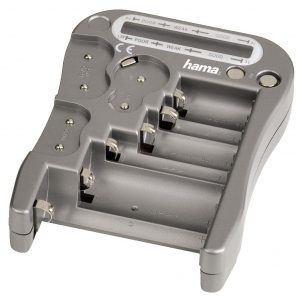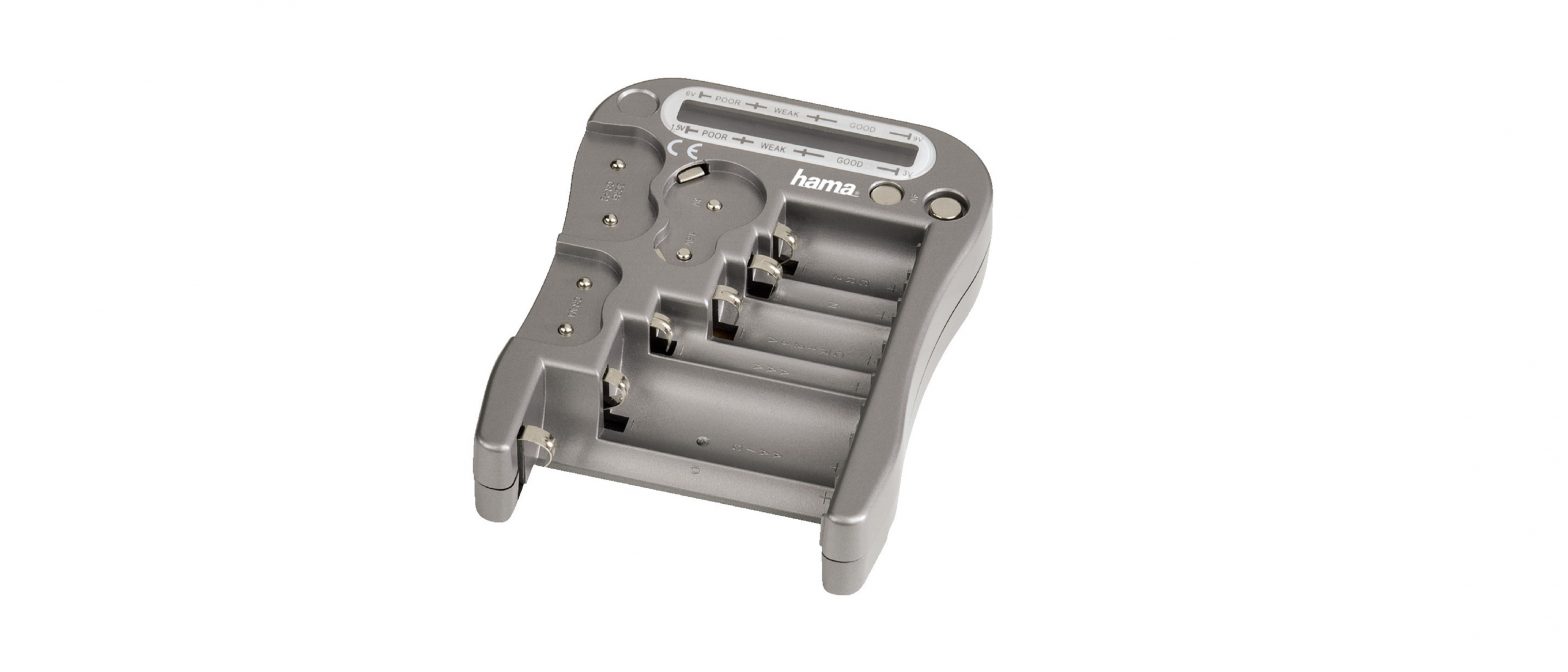hama 00074021 BT2 Battery Tester Instruction Manual
|
US |
Germany | International |
max. Volt |
|
AAA |
Mikro | R03 | 1,5 V |
| AA | Mignon | R 6 |
1,5 V |
|
C |
Baby | R14 | 1,5 V |
| D | Mono | R20 |
1,5 V |
|
N |
Lady | R 1 | 1,5 V |
| E | 9V Block | 6 LR 61 |
9,0 V |
|
CR 123A |
CR 17345 | 3,0 V | |
| CR 2 | CR 2 |
3,0 V |
|
|
2 CR 5 |
2 CR 5 |
6,0 V |
|
|
CR-P2 |
CR-P2 |
6,0 V |
|
|
CRV3 |
CR 17355 |
3,0 V |
|
|
3 V LithiumButtoncells |
3 V Lithium Knopfzellen | 0 max. 21 mm |
3,0 V |
|
1,5 V Buttoncells |
1,5 V Knopfzellen | 0 max. 12 mm |
1,5 V |
Operating instruction
Safety Notes
- The product is intended for private, non-commercial use only.
- Protect the product from dirt, moisture and overheating and use it in dry rooms only.
- Do not drop the product and do not expose it to any major shocks.
- Do not operate the product outside the power limits given in the specifications.
- Do not modify the product in any way. Doing so voids the warranty.
- Dispose of packaging material immediately according to locally applicable regulations.
- Use the product for its intended purpose only.
- Do not use the product in the immediate vicinity of heaters or other heat sources or in direct sunlight.
- Do not use the product in areas where the use of electronic devices is not permitted.
- Use the item only in moderate climatic conditions.
- Do not open the device or continue to operate it if it becomes damaged.
- Do not attempt to service or repair the product yourself. Leave any and all service work to qualified experts.
- Do not short-circuit charger/power supply unit contacts!
- Children who are 8 or older and people with impaired physical, sensory or mental abilities, or those who lack experience and knowledge, may use the device if they are supervised or have been trained in safe use of the device and have understood the associated dangers. Children are not permitted to play with the device. Children may not clean the product or perform user maintenance without supervision.
Getting started
![]() Warning – Batteries
Warning – Batteries
- When inserting batteries, note the correct polarity (+ and – markings) and insert the batteries accordingly. Failure to do so could result in the batteries leaking or exploding.
- Only use batteries (or rechargeable batteries) that match the specified type.
- Before you insert the batteries, clean the battery contacts and the polar contacts.
- Do not allow children to change batteries without supervision.
- Do not mix old and new batteries or batteries of a different type or make.
- Remove the batteries from products that are not being used for an extended period (unless these are being kept ready for an emergency).
- Do not short-circuit batteries.
- Do not charge batteries.
- Do not throw batteries in a fire.
- Keep batteries out of the reach of children.
- Never open, damage or swallow batteries or allow them to enter the environment. They can contain toxic, environmentally harmful heavy metals.
- Immediately remove and dispose of dead batteries from the product.
- Avoid storing, charging or using the device in extreme temperatures and extremely low atmospheric pressure (for example, at high altitudes).Remove the cover of the battery compartment at the rear and insert an AAA battery in the correct direction. The tester is then immediately ready for use.
Testing
Only one battery/rechargeable battery can be tested at a time. The voltage remaining in the battery is shown in the LCD display.
- Select the test slot in accordance with the size of the battery or use the corresponding shapes of the housing. The corresponding battery type names are imprinted on the housing. Insert button cells with the positive pole facing upwards.
- Ensure that the polarity is correct and the contact is secure. Do not insert batteries at an angle. Button cells must touch the side test contact.
- The LCD bar graph shows the residual voltage value of the battery tested.
Display
I—-1 to 5—-IBatteries: Dead – replaceRechargeable batteries: Already deep-discharged – charge immediately. You should avoid discharging the rechargeable batteries this far.
I—————I—– 6 to 11——-IBatteries: Weak, little power left. Only usable in certain circumstances in consumers with low power requirements e.g. clocks etc.Rechargeable batteries: Recharging point reached – recharge as soon as possible.
I—————I——————–l——-12 to 18——-IBatteries: Ok, energy remaining is sufficientRechargeable batteries: Due to the lower cell voltage, rechargeable batteries only reach 13/14 bars when fully charged.
Indicator drops quickly: Battery/rechargeable battery is defective and should no longer be used, e.g. high internal resistance during testing.
Do not use leaking/damaged batteries. Remove the test battery from the device after testing – do not perform continuous battery life testing.
Warranty Disclaimer
Hama GmbH & Co KG assumes no liability and provides no warranty for damage resulting from improper installation/mounting, improper use of the product or from failure to observe the operating instructions and/or safety notes.
Recycling Information
Note on environmental protection:
After the implementation of the European Directive 2012/19/EU and 2006/66/ EU in the national legal system, the following applies: Electric and electronic devices as well as batteries must not be disposed of with household waste. Consumers are obliged by law to return electrical and electronic devices as well as batteries at the end of their service lives to the public collecting points set up for this purpose or point of sale. Details to this are defined by the national law of the respective country. This symbol on the product, the instruction manual or the package indicates that a product is subject to these regulations. By recycling, reusing the materials or other forms of utilising old devices/Batteries, you are making an important contribution to protecting our environment.![]()
Service & Support![]() www.hama.com
www.hama.com![]() +49 9091 502-0
+49 9091 502-0
 Hama GmbH & Co KG 86652 Monheim/ Germany
Hama GmbH & Co KG 86652 Monheim/ Germany
References
[xyz-ips snippet=”download-snippet”]

